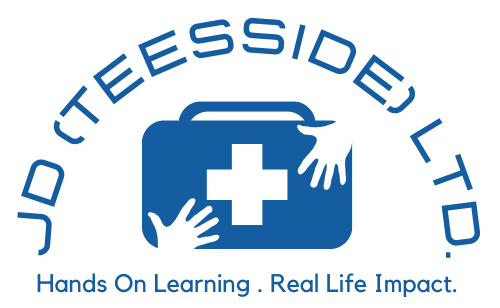Providing Safe, Socially Distanced First Aid Training
This is a live document and will be updated whenever new evidence or guidance comes to light in this fast moving situation.
Coronavirus (COVID19) has led to unprecedented changes to our lifestyle on a scale never experienced before!
Face to face - Classroom induction process:
On Arrival
- All Learners screened anyone exhibiting respiratory COVID-19 symptoms which are a new continuous cough and/or a temperature >37.8 degrees celsius will be excluded.
- Check that no Learner is in a situation where they should be self-isolating (e.g. a family member has had symptoms or the Learner should be shielding as they are in an at risk group). Exclude from the course, as necessary.
- With the Learners permission, their temperature will be checked safely and non-invasively.
- Each Learner will be asked to thoroughly wash hands and sanitise.
- Posters are displayed instructing them that if they need to cough/sneeze this should be done into a tissue that is disposed of immediately. Failing that they should cough into a bent elbow (better than a bare hand) and NEVER cough/ sneeze without covering their mouth/nose. If someone coughs on their hand or uses a tissue, they should use alcohol wipes/sanitizer immediately.
Classroom set up:
- Learners will be seated approx. 2 metres apart. This is highly likely to determine the maximum class size of 8 Learners.
Prior to each class:
- Learners will be shown the following videos below on how Covid-19 spreads and how to wash your hands:
a.
b.
No one should touch their mouth, nose or eyes unless they have just washed their hands or sanitised. We have available for sanitising hands (e.g. sanitising gel or alcohol wipes) and where they can wash their hands.
- This will be Supervised throughout the course.
- We will ask Learners to maintain physical distancing throughout the entire course.
- If the wearing of face protection is introduced these should be worn and removed following appropriate Infection Prevention and Control (IPC) methods.
- Before and after each practical session, Learners will be asked to sanitise or wash their hands.
CPR
- At the time of writing, HSE and DfE still require rescue breaths to be trained and assessed. We will update you if this changes.
Prior to CPR practise
- The protection that we have in place to prevent infection during CPR practise
- We replace the manikin lungs for each learner.
- Each learner is provided with a Disposable Manikin Face Shield
- The One-way valves which stop air coming back out of the manikin mouth and direct expired air out of the back of the head via a filter.
- We provided alcohol/sanitising wipes to be used between learners, to clean the head, body or wherever a person’s hands have been on the manikin.
- Anti-surfactant wipes are used after each session (this removes any bio-film as well as germ killing)
- These steps alone are sufficient to prevent infection.
- The Health and Safety Executive and Consultant Microbiologists at NHS England have approved these measures as being sufficient, however, in the current climate; as you can see we are also issuing each Learner with a personal CPR face shield to provide double failsafe protection.
Unconscious Casualty
- The trainer will demonstrate the recovery position.
- Learners will be assessed by performing the primary survey on a manikin and placing themselves into the recovery position. A professional discussion will follow to ensure the trainer is confident that the Learner’s knowledge and skills meet the assessment requirements.
- The Learner will be asked to sanitise hands before and after touching any shared equipment.
Choking Casualty
- The trainer will demonstrate the correct procedure for treating a choking casualty
- Learners will demonstrate back blows and the correct hand positioning for abdominal thrusts using the simulated choking vest. A professional discussion will follow to ensure the trainer is confident that the Learner’s knowledge and skills meet the assessment requirements
- Any shared equipment between Learners will be wiped down between use
- The Learner will be asked to sanitise hands before and after touching any shared equipment.
Wounds and Bleeding
- The Learner can demonstrate applying a bandage to themselves – on a leg wound if necessary, followed by placing themselves in the appropriate position to treat shock. Alternatively, a wound on a manikin will be simulated. A professional discussion will follow to ensure the trainer is confident that the Learner’s knowledge and skills meet the assessment requirements.
- The Learner will be asked to sanitise hands before and after touching any shared equipment.
- New bandages will be provided for each Learner.
Slings
- The Learner can demonstrate how their own arm would sit into a support and elevated sling by placing the triangular bandage on their own arm. In replacement of tying the sling behind their neck, it is acceptable for them to hold the ends of the sling tight so they can show where the sling would sit and state ‘I would tie it in this position’.
- Clean slings will be provided for each Learner.
- The Learner will be asked to sanitise hands before and after touching any shared equipment
Management of Anaphylaxis
- The Learner can demonstrate how to administer a ‘trainer’ Adrenaline Auto Injector (AAI) on their own thigh before placing themselves into the correct casualty positioning for anaphylactic shock. A professional discussion will follow to ensure the trainer is confident that the Learner’s knowledge and skills meet the assessment requirements.
- The Learner will be asked to sanitise hands before and after touching any shared equipment
- Alcohol/sanitising wipes will be used to clean the trainer Adrenaline Auto Injector (AAI)
